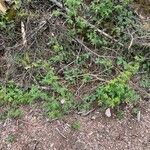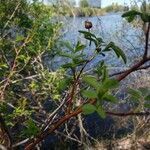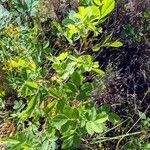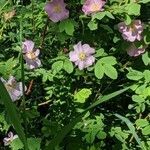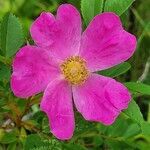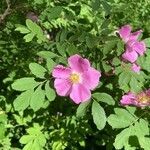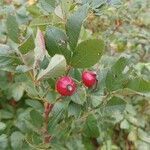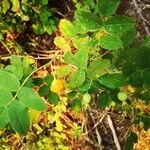Shrubs, forming thickets or ± open stands. Stems erect, slender to stout, 2–20(–50) dm, densely or openly branched; bark dark red, glabrous; infrastipular prickles usually paired, sometimes absent, erect or curved to hooked, declined, or introrse, usually subulate, sometimes terete or flattened, stout, (0.5–)2–7(–13) × 1–5 mm, ?base glabrous?, internodal prickles usually sparse to dense, often intermixed with aciculi. Leaves 2.5–8(–12) cm; stipules (6–)9–16(–25) × 2–5 mm, auricles usually flared, 2–6 mm, margins usually entire, sometimes undulate, sparsely serrate, eglandular or glandular, surfaces glabrous, eglandular, rarely glandular; petiole and rachis with pricklets sparse or absent, usually puberulent-velutinous ?hairs 0.1(–0.5) mm?, rarely glabrate, eglandular, rarely stipitate-glandular; leaflets 5–7(–9), terminal: petiolule 3–12 mm, blade obovate, elliptic, or ovate, rarely cordate, (6–)12–35(–40) × 6–20(–26) mm, ?usually widest at or above middle?, membranous, base cuneate, rarely obtuse, margins 1(–2+)-serrate, teeth (5–)7–14 per side, ?on distal 1/2–4/5 of margin?, acute, usually eglandular, apex acute or obtuse, abaxial surfaces pale green, glabrous, sometimes pubescent or puberulent, eglandular, sometimes glandular, adaxial green, rarely glaucous, dull, glabrous. Inflorescences usually panicles, sometimes corymbs or solitary flowers, 1–10(–25+)-flowered. Pedicels erect, slender, 10–20(–33) mm, glabrous, eglandular, rarely stipitate-glandular; bracts 2, ovate or lanceolate, (6–)9–20 × 4–9 mm, margins entire or ciliate, eglandular, sometimes sparsely glandular, surfaces pubescent, eglandular. Flowers (2–)3–3.5(–5) cm diam.; hypanthium ovoid, rarely oblong or globose, 3–6 × 3–5 mm, glabrous, eglandular, rarely stipitate-glandular, neck (0–)0.5–1 × 1.5–3.5 mm; sepals spreading, ovate-lanceolate, 8–15(–21) × 1.5–2.5 mm, tip 4–6 × 0.3–1(–2) mm, margins usually entire, abaxial surfaces glabrous, eglandular, sometimes sessile-or stipitate-glandular; petals single, pink to deep rose, 15–20(–25) × 15–20(–25) mm; ?stamens 65?; carpels (16–)20–40(–50), styles exsert 1–2 mm beyond stylar orifice (2–2.5 mm diam.) of hypanthial disc (3–5 mm diam.). Hips red, orange-red, or purplish red, globose, depressed-globose, ovoid, oblong, or urceolate, 6–13(–16) × 5–12(–15) mm, fleshy, usually glabrous, eglandular, neck (0–)1–2 × 3–4(–7) mm; sepals persistent, erect to spreading. Achenes basiparietal, 15–40, tan to dark tan, (3.5–)4–5(–6) × 2–4 mm.
More
Colonial; stems to 1 m, appearing stiff and with crowded lvs, provided with straight or somewhat curved, slender infrastipular prickles 3–5 mm, and often with other stout or weak prickles as well; stipules rarely to 15 mm, densely stipitate-glandular, also glandular along the margin; rachis glandular, often also bristly; lfls 5 or 7, mostly 1–2 cm, elliptic or oval, sparsely glandular beneath, the teeth glandular on the longer margin; fls commonly corymbose on lateral branches from stems of the previous year; pedicel and hypanthium generally glabrous; sep persistent, often becoming erect; pet pink, 1.5–2.5 cm; hips red, mostly 6–12 mm thick; 2n=14. Prairies and plains; Minn. to Mo., w. to Mack., e. Wash., e. Oreg., s. Calif., and n. Mex. Our plants, as here described, are var. woodsii. (R. fendleri; R. macounii) The taller and laxer var. ultramontana (S. Watson) Jeps., with larger lfls, is cordilleran. R. woodsii hybridizes with R. blanda.
A stiff shrub. It grows 0.9-2 m high and spreads 1.5 m wide. The stems are purplish brown when young. They are very prickly. They are smooth between the thorns. The leaves usually have 7-9 leaflets. The leaves colour in the autumn. The flowers are single and pink. They are in small clusters.
Can be grown by cuttings or seedlings. Seeds needs scarification.
